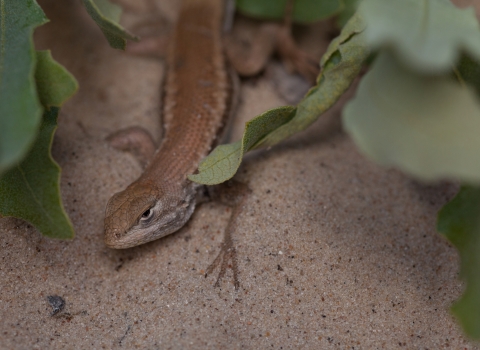The U.S. Fish and Wildlife Service has approved the revised recovery plan for the endangered plant, sentry milk-vetch. The overall goal of the recovery plan is to recover the species so that it no longer needs protections under the Endangered Species Act. The sentry milk-vetch was originally listed as endangered in 1990 under the ESA, and the Service finalized the first recovery plan for the species in 2006. Since then, updated knowledge about the plant and recovery efforts necessitated recovery plan revisions.
Sentry milk-vetch is a narrow endemic found only on the South Rim and the North Rim of Grand Canyon National Park in Arizona. The perennial herb develops into flat, small mats in pockets of shallow soil within the Kaibab limestone, the uppermost rock layer of the Grand Canyon. Its purple flowers, approximately the size of a pencil eraser, commonly attract several kinds of mason bees and other small pollinators.
Sentry milk-vetch’s recovery strategy focuses on ensuring and maintaining resiliency in populations on both the North and the South rims. Recovery objectives include improving the understanding of threats to the species, identifying additional threats, implementing conservation measures to improve resiliency and maintaining resilient populations. The Service will work with the National Park Service, nongovernmental organizations, academia and other conservation partners to implement the recovery plan.
Recovery plans are not regulatory documents, and implementation actions are not required by the ESA. Instead, recovery plans serve as road maps with specific management actions to foster cooperation in conservation for listed species and their ecosystems. This recovery plan describes actions we consider necessary for the recovery of sentry milk-vetch, establishes downlisting and delisting criteria, and estimates the time and cost to implement these recovery actions.
An electronic copy of the final recovery plan is available on ecos.fws.gov/ecp/species/8439. To obtain a copy by mail, send a request to U.S. Fish and Wildlife Service, Arizona Ecological Services Field Office, 9828 North 31st Avenue, Suite C3, Phoenix, AZ 85051 or by phone 602-242-0210.




